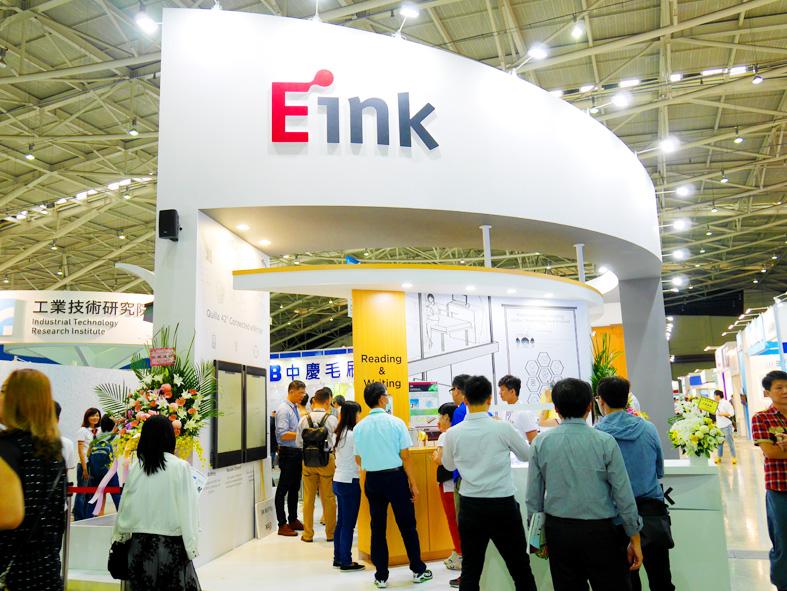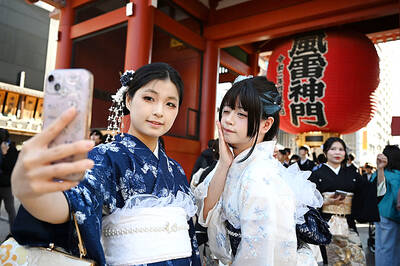E Ink Holdings Inc (元太科技) yesterday announced capacity expansion projects in Taiwan and China, as the world’s biggest e-paper display supplier aims to boost production of e-paper materials and flexible films.
The company plans to invest NT$3.31 billion (US$110.4 million) in Taoyuan’s Guanyin District (觀音) and 3.25 million yuan (US$479,400) at its Chinese facilities in Yangzhou, Jiangsu Province, it said.
The Hsinchu-based firm said its manufacturing capacity continues to be tight and it is unable to fully satisfy customer demand.

Photo: Chen Mei-ying, Taipei Times
Through 2024, the company plans to spend between NT$5 billion and NT$6 billion each year to fund those projects, it said.
“We are relatively positive about our business outlook,” E Ink chairman Johnson Lee (李政昊) told an online investors’ conference. “With more capacity coming online, we expect the third quarter would be better than the second quarter. The fourth quarter would also be better than the third.”
The anticipated sequential growth in revenue and net profit in the second half of the year comes as the world’s major retailers quicken pace in installing electronic shelf labels (ESLs), offsetting weakening demand for e-reader and e-note products, E Ink said.
Although consumers have turned cautious about spending on consumer electronics, including e-readers and e-notes, in the second half of the year, ESL demand remains strong, Lee said.
The shipments of e-reader modules could be 10 percent lower than E Ink’s estimates for this year, but they would still grow over last year, the company said.
More retailers are adopting ESLs rather than paper price tags to adjust prices automatically, Lee said, adding that ESL replacement demand remained strong.
“The ESL market is entering an organic growth phase. We believe it is still in an early stage of growth,” he said.
E Ink expects the penetration rate of ESLs to surpass 10 percent this year, compared with about 5 percent in the past few years.
The market could reach 30 billion or 40 billion units based on some customers’ calculations, he said.
E Ink posted a record-high net profit of NT$2.37 billion for last quarter, surging 71 percent from NT$1.39 billion a year earlier.
The company said it has seen a significant annual growth in e-reader shipments in the first half of this year.
The company’s first-half net profit expanded 50 percent year-on-year to NT$3.84 billion from NT$2.56 billion, while earnings per share rose to NT$3.36 from NT$2.26 a year earlier.

Shiina Ito has had fewer Chinese customers at her Tokyo jewelry shop since Beijing issued a travel warning in the wake of a diplomatic spat, but she said she was not concerned. A souring of Tokyo-Beijing relations this month, following remarks by Japanese Prime Minister Sanae Takaichi about Taiwan, has fueled concerns about the impact on the ritzy boutiques, noodle joints and hotels where holidaymakers spend their cash. However, businesses in Tokyo largely shrugged off any anxiety. “Since there are fewer Chinese customers, it’s become a bit easier for Japanese shoppers to visit, so our sales haven’t really dropped,” Ito

The number of Taiwanese working in the US rose to a record high of 137,000 last year, driven largely by Taiwan Semiconductor Manufacturing Co’s (TSMC, 台積電) rapid overseas expansion, according to government data released yesterday. A total of 666,000 Taiwanese nationals were employed abroad last year, an increase of 45,000 from 2023 and the highest level since the COVID-19 pandemic, data from the Directorate-General of Budget, Accounting and Statistics (DGBAS) showed. Overseas employment had steadily increased between 2009 and 2019, peaking at 739,000, before plunging to 319,000 in 2021 amid US-China trade tensions, global supply chain shifts, reshoring by Taiwanese companies and

Taiwan Semiconductor Manufacturing Co (TSMC) Chairman C.C. Wei (魏哲家) and the company’s former chairman, Mark Liu (劉德音), both received the Robert N. Noyce Award -- the semiconductor industry’s highest honor -- in San Jose, California, on Thursday (local time). Speaking at the award event, Liu, who retired last year, expressed gratitude to his wife, his dissertation advisor at the University of California, Berkeley, his supervisors at AT&T Bell Laboratories -- where he worked on optical fiber communication systems before joining TSMC, TSMC partners, and industry colleagues. Liu said that working alongside TSMC

TECHNOLOGY DAY: The Taiwanese firm is also setting up a joint venture with Alphabet Inc on robots and plans to establish a firm in Japan to produce Model A EVs Manufacturing giant Hon Hai Precision Industry Co (鴻海精密) yesterday announced a collaboration with ChatGPT developer OpenAI to build next-generation artificial intelligence (AI) infrastructure and strengthen its local supply chain in the US to accelerate the deployment of advanced AI systems. Building such an infrastructure in the US is crucial for strengthening local supply chains and supporting the US in maintaining its leading position in the AI domain, Hon Hai said in a statement. Through the collaboration, OpenAI would share its insights into emerging hardware needs in the AI industry with Hon Hai to support the company’s design and development work, as well